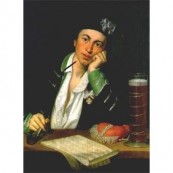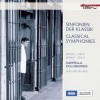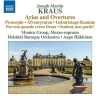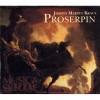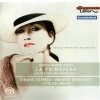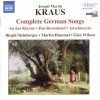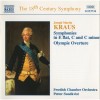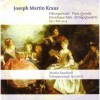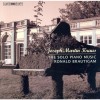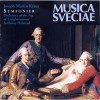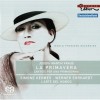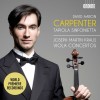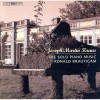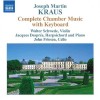Biography
Joseph Martin Kraus (20 June 1756 – 15 December 1792), was a composer in the classical era who was born in Miltenberg am Main, Germany. He moved to Sweden at age 21, and died at the age of 36 in Stockholm. He is sometimes referred to as "the Swedish Mozart",[1] and had a life span which was very similar to that of Mozart's.
Kraus was born in the central German town of Miltenberg in Franconia, the son of Joseph Bernhard Kraus, a County clerk in the Archbishopric of Mainz, and Anna Dorothea née Schmidt. His father's family, originally from Augsburg, had a small restaurant in Weilbach near Amorbach, while his mother was a daughter of the master-builder at Miltenberg Johann Martin Schmidt. Joseph had 13 brothers and sisters, but seven of them died during their childhood.
After a short stay in Osterburken, the Kraus family moved to Buchen (Odenwald) (in Baden-Württemberg) in 1761, where the father Joseph Bernhard Kraus found a position as a clerk; Amtsschreiber. In Buchen, Kraus started his earliest formal education. His first music teachers were rector Georg Pfister (1730–1807) and cantor Bernhard Franz Wendler (1702–1782), giving him mainly piano and violin lessons. Kraus showed his musical talent at a very early stage. At the age of 12, Kraus joined the Jesuit Gymnasium and Music Seminar at Mannheim, where he studied German and Latin literature and music. He received a rigorous musical education, especially in violin technique, from P. Alexander Keck (1724–1804) and P. Anton Klein (1748–1810).
It was the wish of his parents that Joseph Martin Kraus should matriculate as a student of law at the University of Mainz in 1773. However, Kraus was not satisfied with the situation at that university, and even published a satire about it. After only one year, he applied to the University of Erfurt, where he could attend music lessons too. Both Catholic and Evangelical(i.e. Lutheran) music was flourishing in Erfurt, with a rich musical tradition. Very soon, Kraus neglected his studies of law and focused fully on music and literature.
A defamation trial against his father forced Kraus to interrupt his studies for one year and to move back to Buchen. He spent his time in Buchen writing his tragedy Tolon, a drama in three acts, and several musical works for the town-church of St. Oswald. Among others, Kraus wrote a Te Deum in D major and the motet Fracto Demum Sacramento in D Major. After this one year break, he continued his studies of law in Göttingen. Although the Göttinger Hainbund (the German poet group that flourished 1772-74) no longer existed, Kraus found himself very much attracted to the ideas of this group of young poets that offered an almost fanatical devotion to the poet Friedrich Gottlieb Klopstock. In this period Kraus composed a book of poetry, named Versuch von Schäfersgedichte, which is now lost, and consisted of nineteen poems. More and more, he became involved with the Sturm und Drang movement, which influenced both his writing and his music.
In 1775, at the age of nineteen, Kraus wrote his Requiem, one of his earliest compositions. There is no way to know for sure whether young Kraus was induced to compose this genre of church music for personal reasons, or whether his choice may have been influenced by his attraction to the Sturm und Drang movement. Although the signs of the composer's obvious inexperience are easily seen, the work is full of dramatic force and original, bold ideas.
The Requiem was followed by two oratorios: Der Tod Jesu and Die Geburt Jesu (lost), and the musical treatise Etwas von und über Musik fürs Jahr 1777 (Something about Music, for the year 1777).
The oratorio Der Tod Jesu differs from the oratorios of many other composers in that Kraus wrote both the music and the text of this work. As a librettist, Kraus showed a series of scenes that covered the full spectrum of human emotions, from sorrow and fear to joy. The work corresponds fully to a rhetoric question already raised in Kraus's treatise Etwas von und über Musik fürs Jahr 1777:
"Should not church music be mostly for the heart?"
("Soll die Musik in den Kirchen nicht am meisten fürs Herz sein?")
During his stay in Göttingen, Kraus had become friendly with his Swedish fellow student Carl Stridsberg, who persuaded Kraus to accompany him to Stockholm to apply for a position at the court of King Gustav III.
Kraus moved to Stockholm in 1778, at the age of not yet twenty-two. His first years there were not easy, and more than once he considered going back home. King Gustav's love for the fine arts had quickly become known in the rest of Europe and attracted musicians from many countries. It took Kraus three bitter years, often spent in extreme poverty, before the king noticed him. His opera Azire was rejected by the Royal Swedish Academy of Music, but the Academy decided to give him a second chance. Gustav III himself drafted the opera libretto Proserpina, which the poet Johan Henric Kellgren versified. Kraus’s music to this libretto was successfully premiered at Ulriksdal Palace on 6 June 1781, before the king and the royal household. Kraus was appointed vice-Kapellmeister of the Royal Swedish Opera and director of the Royal Academy of Music.
It was the long-awaited breakthrough. Dizzy with the success, Kraus wrote to his parents:
"Immediately after the music ended, the king talked to me for more than a quarter of an hour ... it had simply given him so much satisfaction. Yesterday I was engaged by him. Of course I was not granted any great title, but quite simple that of Kapellmeister. What is worth much more to me than 600 guilders is the favour I have been granted, which is that I am to undertake a journey to Germany, France and Italy at the King's expense."
Gustav III sent Kraus on a Grand Tour of Europe that lasted five years, to learn all he could about Theater abroad. On this trip, Kraus met Christoph Willibald Gluck, Johann Georg Albrechtsberger, Padre Martini and Joseph Haydn, for whom he wrote a Symphony in D major (VB 143) for Haydn to play at Esterháza; it was first published under Haydn's name. Kraus's Symphony in E minor, VB 141 was first published in Paris in 1787, under the name of Giuseppe Cambini, a very popular composer at the time. During this time, Kraus became a member of the same masonic lodge as Wolfgang Amadeus Mozart.
During his journey, Kraus also wrote his famous flute quintet in D Major, that broke with all the erstwhile conventions that governed such pieces. The outer and inner form of that work were groundbreaking comparing with everything previously composed at the time, with the astoundingly long first movement of 306 bars.
After Vienna, his journey also took him throughout Italy, France, and England, where he witnessed the Handel Centenary celebrations at Westminster Abbey in 1785. While in Paris, he experienced difficulty with cabals back in Stockholm that sought to prevent his return, but their resolution in 1786 made it possible for him to become the leading figure in Gustavian musical life.
When Kraus returned in 1787, he was appointed as director of curriculum at the Royal Academy of Music, and the next year he succeeded Francesco Antonio Uttini as Kapellmästare, eventually attaining a reputation as an innovative conductor, progressive pedagogue, and multi-talented composer. He also became a member of the literary circle that gathered round the Architect Erik Palmstedt (who was commissioned by King Gustav III to build the first royal opera house), a group that discussed intellectual and cultural life in the Swedish capital.
For the convening of the Riksdag of the Estates in 1789, Gustav III wanted to persuade the parliament to accede to his ongoing war with Russia, where he was opposed by the nobility but supported by the burghers and the peasantry. To further his aims, Gustav III intended to secure parliamentary approval of the Act of Union and Security that would give him broad powers over the administration of the government. The king asked Kraus to write Riksdagsmusiken for the opening ceremonies in St Nicolai Church on 9 March 1789. The music consists of a march based on the March of the Priests from Mozart's Idomeneo, and a symphony (Sinfonia per la chiesa). The legislature approved the king's measures.
Kraus wrote an overture, a march and interludes for the staging of Voltaire's Olympie in January 1792. Although he was considered as a composer of stage music, his greatest work, Aeneas i Cartago, remained unperformed during his lifetime. 16 March 1792, Gustav III attended a masked ball at the opera, where he was assassinated. The death of Gustav III caused considerable turmoil in the cultural establishment that the monarch had nurtured. Kraus wrote a funeral cantata and the Symphonie funèbre, which were played at the burial ceremony on April 13.
Kraus's own health deteriorated shortly thereafter, and he died only a few months later in December 1792 from tuberculosis. He was buried outside Stockholm at Tivoli following a ceremony where his coffin was carried across the ice of the Brunnsviken by torchlight. His tomb (c. 1833) bears the inscription: Här det jordiska af Kraus, det himmelska lefver i hans toner (which translates to: Here the earthly of Kraus; the heavenly lives in his music)
Bertil H. van Boer divides Kraus's sacred music into two periods. The first, from 1768 to 1777, comprises Kraus's music written as a Roman Catholic for Catholic services. For the second, from 1778 to 1790, Kraus was still Catholic, but wrote music for Lutheran services. Aside from short hymns and chorales, there was not much use for sacred music in Sweden at that time. There was also a debate going on regarding the role music should play in the church, and Kraus participated in that debate by writing three articles on the subject in the Stockholms Posten.
Two different catalogues exist of Kraus's music, one by Karl Schreiber, Verzeichnis der Musikalischen Werke von Jos. Kraus, which gives each composition an A number, and Bertil van Boer's Die Werke von Joseph Martin Kraus: Systematisch-thematisches Werkverzeichnis, which gives each composition a VB number. See the list of compositions by Joseph Martin Kraus.
Bertil van Boer also edited modern editions, on Artaria, recorded on 4 volumes of the Naxos Records complete set of Kraus symphonies, and also wrote the programme notes for those discs as well as the article on Kraus in the New Grove Dictionary of Music and Musicians. Volume 1 won the Cannes Classical Award in 1999, while Volume 2 contains world première recordings of three of Kraus's symphonies. The orchestra Concerto Köln won several prizes for its recordings on period instruments of the complete symphonies of Joseph Martin Kraus.
Kraus's music is characterized by sudden dramatic contrasts in register, character, and most striking of all, harmony. His contrapuntal abilities were first-rate, but his motivic development does not seem as advanced as either Mozart's or Haydn's. Compared to other contemporaries, his lyrical gifts are apparent.
Many of Kraus's symphonies have been lost, or attributed to other composers. Of those definitely of Kraus's authorship, only about a dozen remain. Most of Kraus's extant symphonies are in three movement, without a minuet. Most are scored for two horns and strings, many include two flutes and two oboes, while the later ones also include two bassoons, and two additional horns. The musicologist Bertil van Boer identifies Kraus's Symphony in C sharp minor as "one of only two symphonies in this key written during the eighteenth century." It was later reworked in a more 'manageable' key as Symphony in C minor, VB 142.
It is still disputed as to whether the symphony dedicated to Haydn was Symphony in D major VB 143 or Symphony in C minor VB 142. The minor key and the mood of Symphony VB 142 seem to be a reminiscent of Haydn's "Sturm und Drang" period around 1770, comparable with his earlier minor key works, although based on the first measures of Gluck's overture to Iphigénie en Aulide. In any case, Haydn had a very high opinion of the work. Many years after Kraus's death, Haydn remarked to a common friend, Swedish diplomat Fredrik Samuel Silverstolpe:
"The symphony he wrote here in Vienna especially for me will be regarded as a masterpiece for centuries to come; believe me, there are few people who can compose something like that."





